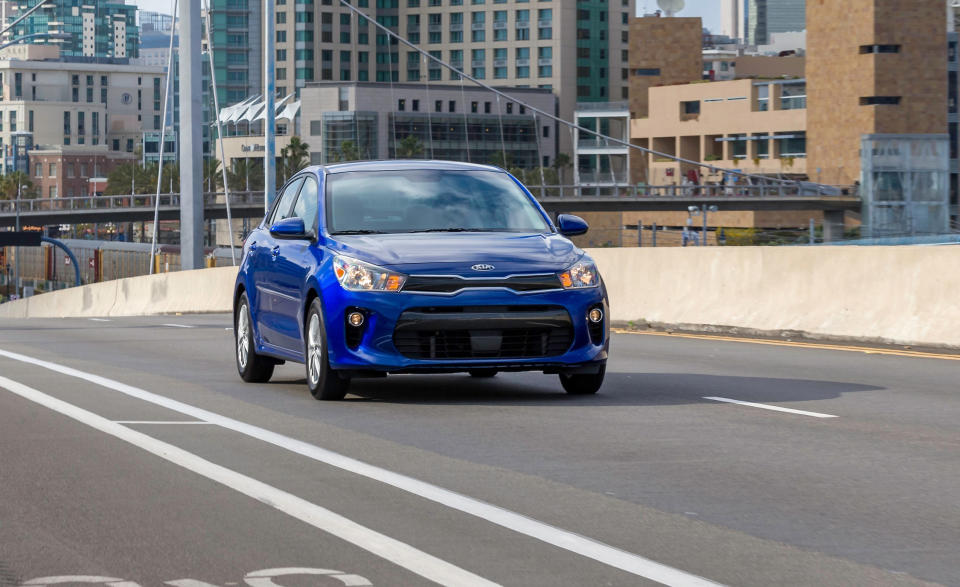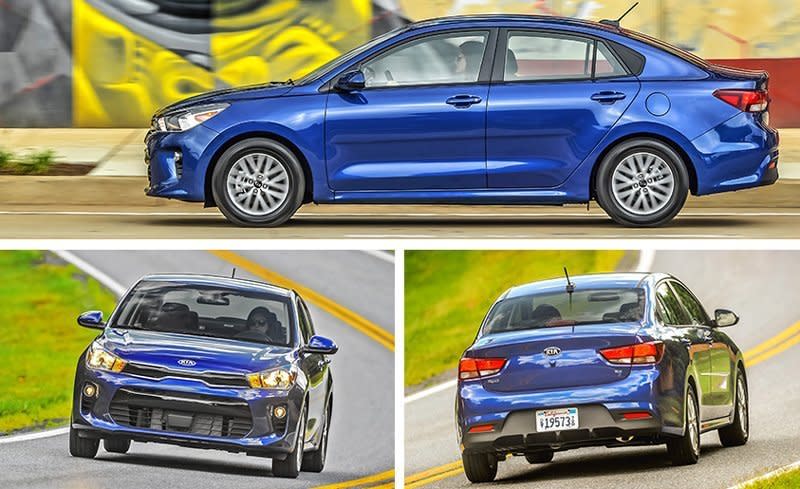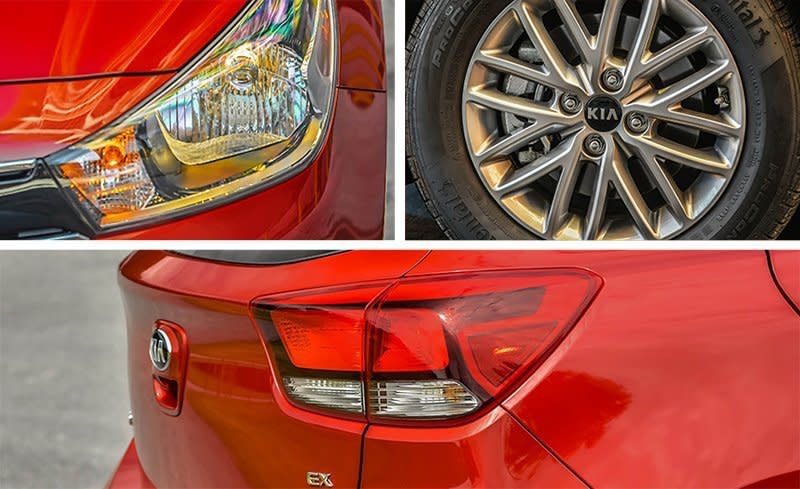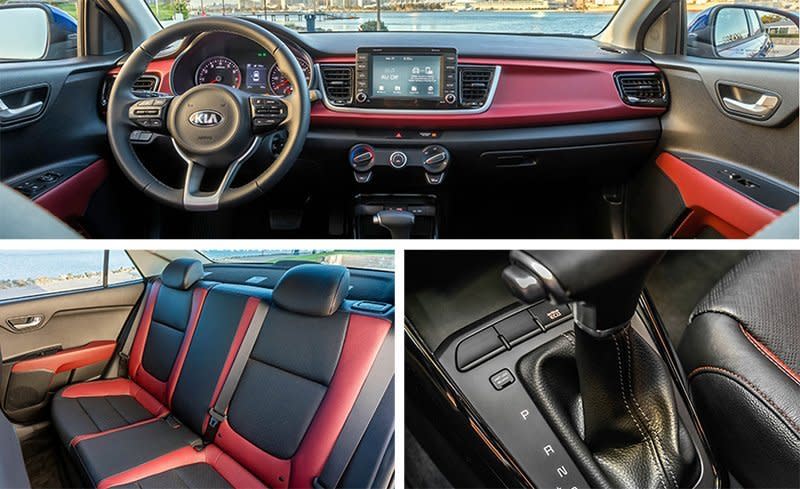2018 Kia Rio

Here in the land of plenty, where pickups, SUVs, and crossovers generally see the most sales action (Ford’s F-series sold 576,334 units in the first eight months of 2017 alone), it’s easy to forget that the subcompact-car segment is still vital. Certainly, from a global perspective, it continues to make sense for automakers to field a competitive small runabout. Take the 2018 Kia Rio. The current model was Kia’s best-selling car globally in 2017 (almost 450,000 units, per Kia), and the new 2018 Rio was redesigned to keep its international popularity strong. The upside is that we profligate Americans get all the benefits of a well-rounded subcompact without having to shoulder the entire cost of development.
Bean Counting
The four-door 2018 Rio is offered as a sedan or a hatchback, and it comes as no surprise that Kia figures 70 percent of buyers in the United States will opt for the sedan, despite the hatchback’s undeniably more attractive proportions. In addition to three regular trim levels—LX, S, and EX—the new Rio also can be had as a loaded Launch Edition that will be available through the 2018 model year.

Regardless of trim level, navigation is off the table. Full stop. After years of pushing the tech-for-the-price envelope, Kia has concluded that eliminating factory navigation is an effective way to keep the price within reach of the Rio’s ostensibly youthful demographic. The rub is that only the top-tier EX and Launch Edition get Apple CarPlay or Android Auto compatibility. The rest of us will be left to our cellular devices, although at this point they’re so integrated with the human condition that we suspect few buyers in this segment will mind.
Pursuit of fiscal efficiencies also led to the virtual elimination of the Rio’s options (the sole extra-cost item as of this writing being leather upholstery with red accents on the EX). Without the ability to add features, Rio shoppers will want to choose their trim level wisely. The base LX, for example, has crank windows and manually adjusted side mirrors, and it rolls on 15-inch steel wheels; Bluetooth, cruise control, a backup camera, a center-console armrest, and keyless entry are not available. (Starting May 1, 2018, all new cars are required to have a backup camera as standard, so we expect that the LX trim will adopt the feature.) The midrange S trim level does get Bluetooth and a backup camera but uses rear drum brakes and makes do without a telescopic steering wheel (all Rios get tilt) and visor vanity mirrors, among other minor details. While all three trims are equipped with satellite radio, the LX and S use a tiny 5.0-inch screen while the top-spec EX gets a 7.0-inch unit to make the most of the Apple CarPlay/Android Auto hookup. Only the EX includes aluminum wheels, a telescoping column, automated emergency braking, a leather-wrapped steering wheel and shifter, and a few other items. In a spectacular example of micro bean counting, all three employ a four-speaker sound system, but only the upper two models get dedicated tweeters for a total of six speakers.
Soul Power
The minimalist theme continues under the Rio’s hood. The same direct-injected 1.6-liter inline-four used in the previous Rio and the current base Soul is the only available engine. (The Europe-market 2018 Rios we drove earlier featured three entirely different engines.) Rated at 130 horsepower and 119 lb-ft of torque, output drops by 8 hp and 4 lb-ft, but what’s there arrives at lower rpm (a vague power graph the company produced shows a slight increase of torque at 1500 rpm in comparison with the engine’s previous tune). Although both six-speed manual and six-speed automatic transmissions are offered, Kia believes only around 5 percent of buyers will want the row-your-own gearbox and limits its availability to the base LX.

For our first exposure to the U.S.-spec Rio, Kia had only top-drawer EX models on hand. The upside is the overwhelming majority of test vehicles were hatchbacks, which is our preferred version of the Rio for both aesthetic and practical reasons, despite America’s peculiar preference for the sedan.
Acceleration provided by the 1.6-liter four-pot, as you might guess, is leisurely. What power there is comes on in linear fashion—unsurprisingly, for a naturally aspirated engine—and shifts are tuned for comfort. Even under full throttle in Sport mode (which alters throttle response and changes shift mapping), the gear swaps are clandestine, with the priority on a smooth handoff. If it weren’t for the engine sound you might think the transmission was a CVT. The brake pedal delivers measured response and better modulation than it probably needs to. Hard braking from 75 mph in the rain revealed a short and drama-free stop, thanks to early intervention of the anti-lock brakes.
Sound Salvation
Kia claims the new platform reflects a 30 percent increase in tensile strength over the previous Rio; while we can’t verify that claim, we can say it feels tight and solid. The suspension is via struts up front with a torsion beam at the rear—inexpensive small-car design 101. We managed to bottom out the suspension only once, hammering the Rio over the rough, brick-paved streets of Baltimore’s Fells Point neighborhood, and the only indicator of the abuse was a minor rattle from the hatch. Highway travel was similarly quiet, the 15-inch Continental ProContact TX 165/65R-15 all-season tires rolling over concrete and asphalt without much audio drama. While far from sporting, the steering is linear and the Rio doesn’t protest when aimed down a twisty back road; Kia PR never missed an opportunity to remind us that the Rio was developed for the European market. Although its limits are low, the entire package is reasonably well balanced, and you can have a bit of fun if you subscribe to the drive-a-slow-car-fast school of thought.

Interior materials consist of mid-grade plastics typical of the segment, and the three-knob HVAC controls are simple enough. Passengers will find interior space a mixed bag. The ample front seats and airy cabin offer enough space for people sized just on the small side of NFL linemen, but what Kia giveth in front it taketh in the rear: The reasonably comfortable rear seat bottoms and seatbacks are essentially pointless given the dearth of legroom. The sedan’s cargo hold offers only 14 cubic feet of space against the hatchback’s 17 cubes, which is increased to 33 with the back seats folded. By comparison, the Honda Fit has 17 cubes behind the rear seats and the Ford Fiesta has 15.
Dollar Dilemma
Given the current modest cost of fuel in the U.S., pricing is the critical factor for subcompact cars. The entry-level Rio LX sedan starts at $14,885 with the manual transmission; add a grand for the automatic. The more desirable Kia Rio hatch carries a $300 premium. Kia isn’t ready to reveal pricing for the S, EX, and Launch Edition models yet, but we expect the Rio to top out around $20K. At that price, Kia’s own Soul and Forte, two economical models with more interior space, become attractive alternatives. Even with its minimal equipment, the lower-spec Rio strikes us as highly likely to appeal, drawing buyers looking for an inexpensive small car with a long warranty. They’ll like it just fine.
Specifications >
VEHICLE TYPE: front-engine, front-wheel-drive, 5-passenger, 4-door sedan or hatchback
BASE PRICES: sedan, $14,885;
hatchback, $15,185
ENGINE TYPE: DOHC 16-valve inline-4, aluminum block and head, direct fuel injection
Displacement: 97 cu in, 1591 cc
Power: 130 hp @ 6300 rpm
Torque: 119 lb-ft @ 4850 rpm
TRANSMISSIONS: 6-speed manual; 6-speed automatic with manual shifting mode
DIMENSIONS:
Wheelbase: 101.6 in
Length: 160.0–172.6 in
Width: 67.9 in Height: 57.1 in
Passenger volume: 90 cu ft
Cargo volume (sedan/hatchback): 14/17 cu ft
Curb weight (C/D est): 2650–2750 lb
PERFORMANCE (C/D EST):
Zero to 60 mph: 8.9–9.1 sec
Zero to 100 mph: 26.0–26.4 sec
Standing ¼-mile: 16.8–16.9 sec
Top speed: 115 mph
EPA FUEL ECONOMY:
Combined/city/highway: 32/28–29/37 mpg

 Yahoo Autos
Yahoo Autos 